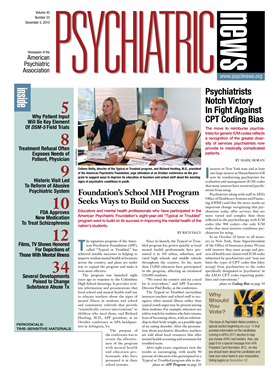Co-occurring psychiatric and substance use conditions are a common combination, not an exception, and demand a simultaneous, multifront approach to treatment, said Kenneth Minkoff, M.D., at APA's Institute for Psychiatric Services in Boston in October.
“Which problem is primary?” Minkoff asked his audience. “All problems are primary, and the correct intervention is to deal with all the problems at the same time.”
This comprehensive, continuous, integrated system of care (CCISC) rests on evidence-based principles of treatment articulated through clinical strategies applied by all members of the clinical team, he said.
The CCISC approach has been used in some way in 28 states and dozens of other jurisdictions, said Minkoff, manager of operations and senior advisor at ZiaPartners Inc., a behavioral-health consulting firm in San Rafael, Calif.
Minkoff said his goal is to develop an empathic, integrated, strength-based relationship with patients. Rather than starting with the patients' failures, he suggested, look at the times when they succeeded in not using substances. Discuss how they got to that point, how they stayed there, and when and why they went backward.
“Listen closely to patients on the first visit,” he advised. “Get good at getting people's stories, not just their symptoms, then help them articulate their personal vision of treatment and outcomes.”
Patients may have issues in many categories, not just addiction in combination with psychiatric disorder, but also general medical, housing, and employment problems.
The clinical team should identify each applicable issue then develop what Minkoff called a “parallel primary recovery process” to help patients move through stages of change and phases of recovery for each co-occurring condition.
Patients can be assessed in six dimensions, said David Mee-Lee, M.D., who spoke on the same panel: intoxication levels, biomedical conditions, emotional/behavioral issues, readiness to change, potential for relapse, and relapse prevention.
“Finally, there is the recovery environment in which the patient lives: the family, legal, work, and financial settings,” said Mee-Lee, who is senior vice president at the Change Companies in Carson City, Nev.
“The stages-of-change process is problem specific, not person specific,” Minkoff said. “Help people make little bits of progress without struggling. Breaking down the process into small steps makes it easier to do.”
For these patients, treatment is about learning first how to play an informed role in planning and managing their own treatment, and then in gaining self-management skills and a willingness to seek help from professionals, family, and peers when they hit rough spots.
And since hurdles do arise on the road to recovery, some kind of contingency planning is necessary, he said. “Don't create a learning process that moves faster than the person can handle.”
If a patient was taking medications 75 percent of the time, try to get him or her to 80 percent, rather than 100 percent, for example.
Rewards are better than punishment, so applaud any small increment of success, he said.
Ultimately, the clinical team and the patient have to share an understanding of the patient's condition from his or her point of view, the diagnoses that the doctors have given the patient, and the treatment plan.
The patient's “job” means first coming to terms with the reality of having a substance abuse problem along with another psychiatric illness and then deciding that he or she wants neither and develops an identity than involves treatment for both, said Minkoff.
“It is our job to understand the patients' job, to join them in it, and help them do better,” he said.


